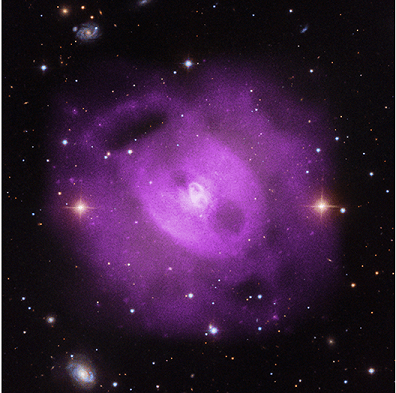Chandra X-ray Observatory Finds Evidence for Serial Black Hole Eruptions
By analyzing the observations from the NASA's Chandra X-ray Observatory (CXO), formerly known as Advanced X-ray Astrophysics Facility (AXAF), astronomers have discovered black hole eruptions by examining the group of galaxies called ‘NGC 5813’. This is the longest ever data of a galaxy group (lasting for about a week) obtained in X-ray light via the CXO. The supermassive black hole, positioned in the central galaxy of the group, is about 105 million light years away from the planet Earth. According to the researchers, the cosmic landscape at the centre of NGC 5813 has been rearranged due to the multiple eruptions from the black hole that occurred in more than 50 million years.
The galaxy groups (made up of up to 50 galaxies), unlike galaxy clusters, are immersed in a very huge reservoir of hot gas that produce and discharge X-rays. A rotating, tightly wound vertical tower of magnetic field is generated owing to the black hole’s spin along with the gas spiral moving towards it. Thereby, the magnetic field hurls a large fraction of the inflowing gas surrounding the black hole forcefully in a high-speed jet.

Moreover, the length of the eruptions was found out by scrutinizing cavities or giant bubbles in the exceedingly hot gas present in the NGC 5813. The giant bubbles are created when the jets from the black hole generate shock waves and then thrust the gas in the outward direction. As a result, huge holes are created. The recent observations showed a third pair of cavities (two pairs of cavities were already discovered), thus demonstrating three distinct eruptions from the black hole of NGC 5813. This helped the researchers to understand the history of the eruptions. The third pair of cavities represents the highest number of pairs ever found till date.
The researchers discovered that the amount of energy needed for producing the pair of cavities in the vicinity of the black hole is less than the energy required for developing the previous two pairs. But, the rate of energy produced is almost same in all the three pairs. Furthermore, the eruptions related to the inner pair of cavities are still taking place.
The findings of the study were reported in a research paper which was published online in the Astrophysical Journal.
Source: <a href="https://www.nasa.gov/mission_pages/chandra/chandra-finds-evidence-for-serial-black-hole-eruptions.html" target="_blank" rel="nofollow noopener noreferrer">Chandra Finds Evidence for Serial Black Hole Eruptions | NASA</a>
The galaxy groups (made up of up to 50 galaxies), unlike galaxy clusters, are immersed in a very huge reservoir of hot gas that produce and discharge X-rays. A rotating, tightly wound vertical tower of magnetic field is generated owing to the black hole’s spin along with the gas spiral moving towards it. Thereby, the magnetic field hurls a large fraction of the inflowing gas surrounding the black hole forcefully in a high-speed jet.
Moreover, the length of the eruptions was found out by scrutinizing cavities or giant bubbles in the exceedingly hot gas present in the NGC 5813. The giant bubbles are created when the jets from the black hole generate shock waves and then thrust the gas in the outward direction. As a result, huge holes are created. The recent observations showed a third pair of cavities (two pairs of cavities were already discovered), thus demonstrating three distinct eruptions from the black hole of NGC 5813. This helped the researchers to understand the history of the eruptions. The third pair of cavities represents the highest number of pairs ever found till date.
The researchers discovered that the amount of energy needed for producing the pair of cavities in the vicinity of the black hole is less than the energy required for developing the previous two pairs. But, the rate of energy produced is almost same in all the three pairs. Furthermore, the eruptions related to the inner pair of cavities are still taking place.
The findings of the study were reported in a research paper which was published online in the Astrophysical Journal.
Source: <a href="https://www.nasa.gov/mission_pages/chandra/chandra-finds-evidence-for-serial-black-hole-eruptions.html" target="_blank" rel="nofollow noopener noreferrer">Chandra Finds Evidence for Serial Black Hole Eruptions | NASA</a>
0
